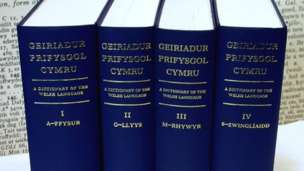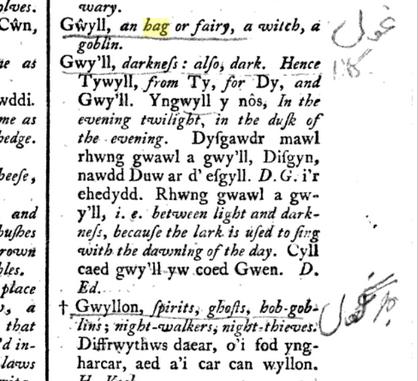Red Fairies #4: Added in Translation? February 5, 2016
Author: Beach Combing | in : Medieval, Modern , trackback
Perhaps the real key to the Red Fairies problem is language. As we have established they are referred to as y Gwilliaid Cochion Mowddwy in Pennant our first extensive source. Let’s work backwards. Mowddwy refers to their region, modern Mawddwy. No problem there. Cochion refers to a deep red colour. Again no problem or controversy. (Some have asked why the bandits are red: is it blood, hair… On the basis of our second post it would be hair.) The difficulty is with the first word: Gwilliaid is used in Welsh to refer to bandits but it can have a secondary meaning of ‘goblins’ or supernatural creatures. Unfortunately for those who dream of Welsh elves offing agents of English colonialism in the 1500s (funded by the red fairy underground doubtless) ‘goblins’ does not seem to have been or to have become the primary meaning of the word. For example, the Geiriadur Prifysgol Cymru, the national Welsh dictionary and one of the great works of recent British scholarship claims that gwilliaid had this or a similar meaning stretching back into the fifteenth and possibly the fourteenth century. In fact, it gives us the following primary meanings: Herwr (bandit), ysbeiliwr (brigand), lleidr (robber), môr-leidr (pirate), cnaf (rogue), dihiryn (skulker), llerciwr (vagabond), gwibiwr (renegade), crwydryn (tramp?); Galiad (a Gaul). Pennant translates them routinely and rather charmingly as ‘banditti’. One of our finest living Welsh folklorists Robin Gwyndaf also translates them as ‘The Red Bandits’. The earliest historical goblin reference Beach has found is in the Archaeologia Cambrensis 5 (1854) where one writer notes
They were called Y Gwylliaid Cochion. Y Gwylliaid according to Richards, of Coychurch, in his Thesaurus are ‘spirits, ghosts, hobgoblins’ and ‘Gwyll’ an ‘hag’ or ‘fairy.’ ‘Red fairies’ would, I suppose, be the best translation.
The relevant passage of Richards’ 1753 Thesaurus is cut and paste here.
The Geiriadur Prifysgol Cymru has not taken up this interpretation and is Gwyllon, in any case, the same word?
The most important moment in the development of the red fairy idea came in 1888. Wirt Sikes, not the best disciplined folklorist took up the red fairies and ran with them in his British Goblins. The idea went, regrettably and with little justification, mainstream in the late nineteenth and the early twentieth century. Sikes in this, and many other cases, had extraordinary and undeserved influence. We seem to have a case, not of something lost in translation, but of something rather sneakily added. The Red Bandits have been suffering ever since. Let’s give them back their violent dignity and remove the elf ears.
Other views on this, perhaps with particular reference to late medieval or early modern Welsh: drbeachcombing AT yahoo DOT com
25 Feb 2016: Philip C writes in with an unexpected problem ‘I’m puzzled – your post #4 on Red Fairies includes a picture of a page from Richards’ 1753 Thesaurus and in the margin someone seems to have been giving transliterations in Arabic script. Can this be?’
Beach suggested short-hand. Philip gets back:
Looks like Arabic to me. Top right corner says (in Arabic) GHUL. The fishhhook with a dot on top is Arabic GH, the curly bit that comes next (reading right to left) is U, the final pothanger shape is L. All are perfectly normal Arabic. Directly underneath are squiggles I can’t make sense of, but the bent paperclip looks like K – but no, I can’t make real sense of it as Arabic. At the foot of the page the GHUL letters again, but over-written with something incomprehensible to me, But if you want to folow this up it would be best to get someone who really does read Arabic – I merely “learnt” it for a year in Cairo.



